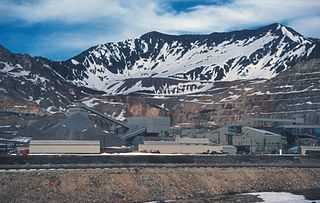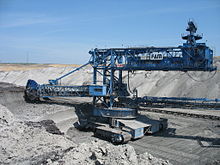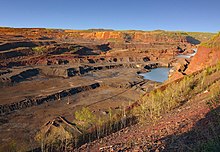
Mining is the extraction of valuable geological materials and minerals from the surface of the Earth. Mining is required to obtain most materials that cannot be grown through agricultural processes, or feasibly created artificially in a laboratory or factory. Ores recovered by mining include metals, coal, oil shale, gemstones, limestone, chalk, dimension stone, rock salt, potash, gravel, and clay. The ore must be a rock or mineral that contains valuable constituent, can be extracted or mined and sold for profit. Mining in a wider sense includes extraction of any non-renewable resource such as petroleum, natural gas, or even water.

Ore is natural rock or sediment that contains one or more valuable minerals concentrated above background levels, typically containing metals, that can be mined, treated and sold at a profit. The grade of ore refers to the concentration of the desired material it contains. The value of the metals or minerals a rock contains must be weighed against the cost of extraction to determine whether it is of sufficiently high grade to be worth mining and is therefore considered an ore. A complex ore is one containing more than one valuable mineral.

Iron ores are rocks and minerals from which metallic iron can be economically extracted. The ores are usually rich in iron oxides and vary in color from dark grey, bright yellow, or deep purple to rusty red. The iron is usually found in the form of magnetite (Fe
3O
4, 72.4% Fe), hematite (Fe
2O
3, 69.9% Fe), goethite (FeO(OH), 62.9% Fe), limonite (FeO(OH)·n(H2O), 55% Fe), or siderite (FeCO3, 48.2% Fe).

Open-pit mining, also known as open-cast or open-cut mining and in larger contexts mega-mining, is a surface mining technique that extracts rock or minerals from the earth using a pit, sometimes known as a borrow pit.

Malachite is a copper carbonate hydroxide mineral, with the formula Cu2CO3(OH)2. This opaque, green-banded mineral crystallizes in the monoclinic crystal system, and most often forms botryoidal, fibrous, or stalagmitic masses, in fractures and deep, underground spaces, where the water table and hydrothermal fluids provide the means for chemical precipitation. Individual crystals are rare, but occur as slender to acicular prisms. Pseudomorphs after more tabular or blocky azurite crystals also occur.

In mining, tailings or tails are the materials left over after the process of separating the valuable fraction from the uneconomic fraction (gangue) of an ore. Tailings are different from overburden, which is the waste rock or other material that overlies an ore or mineral body and is displaced during mining without being processed.

Acid mine drainage, acid and metalliferous drainage (AMD), or acid rock drainage (ARD) is the outflow of acidic water from metal mines and coal mines.
Boliden AB is a Swedish multinational metals, mining, and smelting company headquartered in Stockholm. The company produces zinc, copper, lead, nickel, silver, and gold, with operations in Sweden, Finland, Norway, and Ireland.

The Bingham Canyon Mine, more commonly known as Kennecott Copper Mine among locals, is an open-pit mining operation extracting a large porphyry copper deposit southwest of Salt Lake City, Utah, in the Oquirrh Mountains. The mine is the largest man-made excavation, and deepest open-pit mine in the world, which is considered to have produced more copper than any other mine in history – more than 19,000,000 short tons. The mine is owned by Rio Tinto Group, a British-Australian multinational corporation. The copper operations at Bingham Canyon Mine are managed through Kennecott Utah Copper Corporation which operates the mine, a concentrator plant, a smelter, and a refinery. The mine has been in production since 1906, and has resulted in the creation of a pit over 0.75 miles (1,210 m) deep, 2.5 miles (4 km) wide, and covering 1,900 acres. It was designated a National Historic Landmark in 1966 under the name Bingham Canyon Open Pit Copper Mine. The mine experienced a massive landslide in April 2013 and a smaller slide in September 2013.

Silver mining is the extraction of silver by mining. Silver is a precious metal and holds high economic value. Because silver is often found in intimate combination with other metals, its extraction requires the use of complex technologies. In 2008, approximately 25,900 metric tons of silver were consumed worldwide, most of which came from mining. Silver mining has a variety of effects on the environment, humans, and animals.

Iron Mountain Mine, also known as the Richmond Mine at Iron Mountain, is a mine near Redding in Northern California, US. Geologically classified as a "massive sulfide ore deposit", the site was mined for iron, silver, gold, copper, zinc, quartz, and pyrite intermittently from the 1860s until 1963. The mine is the source of extremely acidic mine drainage which also contains large amounts of zinc, copper, and cadmium. One of America's most toxic waste sites, it has been listed as a federal Superfund site since 1983.

The following outline is provided as an overview of and topical guide to mining:

The Climax mine, located in Climax, Colorado, United States, is a major molybdenum mine in Lake and Summit counties, Colorado. Shipments from the mine began in 1915. At its highest output, the Climax mine was the largest molybdenum mine in the world, and for many years it supplied three quarters of the world's supply of molybdenum.

Environmental effects of mining can occur at local, regional, and global scales through direct and indirect mining practices. Mining can cause erosion, sinkholes, loss of biodiversity, or the contamination of soil, groundwater, and surface water by chemicals emitted from mining processes. These processes also affect the atmosphere through carbon emissions which contributes to climate change. Some mining methods may have such significant environmental and public health effects that mining companies in some countries are required to follow strict environmental and rehabilitation codes to ensure that the mined area returns to its original state. Mining can provide various advantages to societies, yet it can also spark conflicts, particularly regarding land use both above and below the surface.

Leviathan Mine is a United States superfund site at an abandoned open-pit sulfur mine located in Alpine County, California. The mine is located on the eastern slope of the Sierra Nevada at about 7,000-foot (2,100 m) elevation, 6 miles (9.7 km) east of Markleeville and 24 miles (39 km) southeast of Lake Tahoe. The mine site comprises approximately 250 acres (100 ha) of land surrounded by the Toiyabe National Forest, which is only accessible a few months a year. The approximately 22 million tons of sulfur ore-containing crushed rock at the mine are responsible for contaminating the Leviathan and Aspen Creek, which join with Mountaineer Creek to form Bryant Creek which ultimately empties into the East Fork of the Carson River. These water bodies are listed as 303(d) impaired. The site location is seismically active.
Rampura Agucha is a zinc and lead mine located on a massive sulfide deposit in the Bhilwara district of Rajasthan, India. Rampura Agucha is located 220 km (140 mi) from Jaipur. It is north of Bhilwara, and northwest of Shahpura. Rampura Agucha is 10 km (6.2 mi) southeast of Gulabpura on NH 79. The mine is owned by Hindustan Zinc Limited (HZL), and has the world's largest deposits of zinc and lead.

A nickel mine is a mine that produces nickel. Some mines produce nickel primarily, while some mines produce nickel as a side-product of some other metal that has a higher concentration in the ore.

The New Idria Mercury Mine encompasses 8,000 acres of land in the Diablo Mountain range, incorporating the town of Idria in San Benito County, California. Idria, initially named New Idria, is situated at 36°25′01″N120°40′24″W and 2440 feet (680m) above mean sea level. The area was, in the past, recorded in the US Census Bureau as a rural community; however, Idria has become a ghost town since the closing of once lucrative mining operations in the early 1970s.

Mount Polley mine is a Canadian gold and copper mine located in British Columbia near the towns of Williams Lake and Likely. It consists of two open-pit sites with an underground mining component and is owned and operated by the Mount Polley Mining Corporation, a wholly owned subsidiary of Imperial Metals. In 2013, the mine produced an output of 38,501,165 pounds (17,463,835 kg) of copper, 45,823 ounces of gold, and 123,999 of silver. The mill commenced operations in 1997 and was closed and placed on care and maintenance in 2019. The company owns 20,113 hectares (201.13 km2) of property near Quesnel Lake and Polley Lake where it has mining leases and operations on 2,007 hectares (20.07 km2) and mineral claims on 18,106 hectares (181.06 km2). Mineral concentrate is delivered by truck to the Port of Vancouver.
Sisson Mine is a proposed tungsten and molybdenum mine which would be sited near the town of Stanley, 60 km North-West of Fredericton, New Brunswick, Canada. The mine would be among the world's largest tungsten mines, with reserves equating to 227 kilotonnes of elemental tungsten (W). The claim owner, Sisson Mines Ltd., proposes to mine 30,000 tonnes per day of ore which contains on average 0.06 per cent tungsten trioxide (WO3) and smaller amounts of molybdenum. The tungsten component of the ore would be refined into an intermediate product ammonium paratungstate (APT) for shipment. Five hundred fifty seven thousand metric ton units (mtu) of APT would be produced per year, which equates to 4,457 tonnes of tungsten metal per year.




















